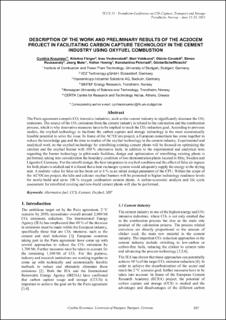| dc.contributor.author | Kroumian, Cynthia | |
| dc.contributor.author | Fleiger, Kristina | |
| dc.contributor.author | Veckenstedt, Ines | |
| dc.contributor.author | Voldsund, Mari | |
| dc.contributor.author | Cavalett, Otávio | |
| dc.contributor.author | Roussanaly, Simon | |
| dc.contributor.author | Maier, Joerg | |
| dc.contributor.author | Hoenig, Volker | |
| dc.contributor.author | Peloriadi, Konstantina | |
| dc.contributor.author | Scheffknecht, Günter | |
| dc.date.accessioned | 2021-09-29T08:07:55Z | |
| dc.date.available | 2021-09-29T08:07:55Z | |
| dc.date.issued | 2021 | |
| dc.identifier.isbn | 978-82-536-1714-5 | |
| dc.identifier.issn | 2387-4295 | |
| dc.identifier.uri | https://hdl.handle.net/11250/2785903 | |
| dc.description.abstract | The Paris agreement compels CO2 intensive industries, such as the cement industry to significantly decrease the CO2 emissions. The source of the CO2 emissions from the cement industry is related to the calcination and the combustion process, which is why innovative measures have to be implied to reach the CO2 reduction goal. According to previous studies, the oxyfuel technology to facilitate the carbon capture and storage technology is the most economically feasible potential to solve the issue. In frame of the AC²OCem project, a European consortium has come together to reduce the knowledge gap and the time to market of the oxyfuel technology in the cement industry. Experimental and analytical work on the oxyfuel technology for retrofitting existing cement plants will be focused on optimizing the calciner and the oxyfuel burner with 100 % alternative fuels. In addition to the experimental and analytical tests regarding the burner technology in pilot-scale facilities, design and optimization of retrofitting existing plants is performed, taking into consideration the boundary condition of two demonstration plants located in Slite, Sweden and Lägerdorf, Germany. For the retrofit design, the heat integration in oxyfuel condition and the effect of false air ingress for both plants is studied and it is found that a heat exchanger system would adequately supply the energy to the drying unit. A realistic value for false air has been set at 6 % as an initial design parameter of the CPU. Within the scope of the AC²OCem project, the kiln and calciner oxyfuel burners will be promoted to higher technology readiness levels for newly-build and up-to 100 % oxygen combustion cement plants. A techno-economic analysis and life cycle assessment for retrofitted existing and new-build cement plants will also be performed. | en_US |
| dc.language.iso | eng | en_US |
| dc.publisher | SINTEF Academic Press | en_US |
| dc.relation.ispartof | TCCS–11. CO2 Capture, Transport and Storage. Trondheim 22nd–23rd June 2021.
Short Papers from the 11th International Trondheim CCS Conference | |
| dc.relation.ispartofseries | SINTEF Proceedings;7 | |
| dc.rights | CC BY 4.0 | * |
| dc.rights.uri | https://creativecommons.org/licenses/by/4.0/ | * |
| dc.subject | Alternative fuel | en_US |
| dc.subject | CCS | en_US |
| dc.subject | Cement | en_US |
| dc.subject | Oxyfuel | en_US |
| dc.subject | SRF | en_US |
| dc.title | Description of the Work and Preliminary Results of the Ac2ocem Project in Facilitating Carbon Capture Technology in the Cement Industry Using Oxyfuel Combustion | en_US |
| dc.type | Chapter | en_US |
| dc.type | Peer reviewed | en_US |
| dc.type | Conference object | en_US |
| dc.description.version | publishedVersion | en_US |
| dc.rights.holder | © 2021 The Authors. Published by SINTEF Academic Press. | en_US |
| dc.subject.nsi | VDP::Teknologi: 500 | en_US |
| dc.identifier.cristin | 1937622 | |
| dc.relation.project | Horisont 2020: EC/H2020/299663 | en_US |

